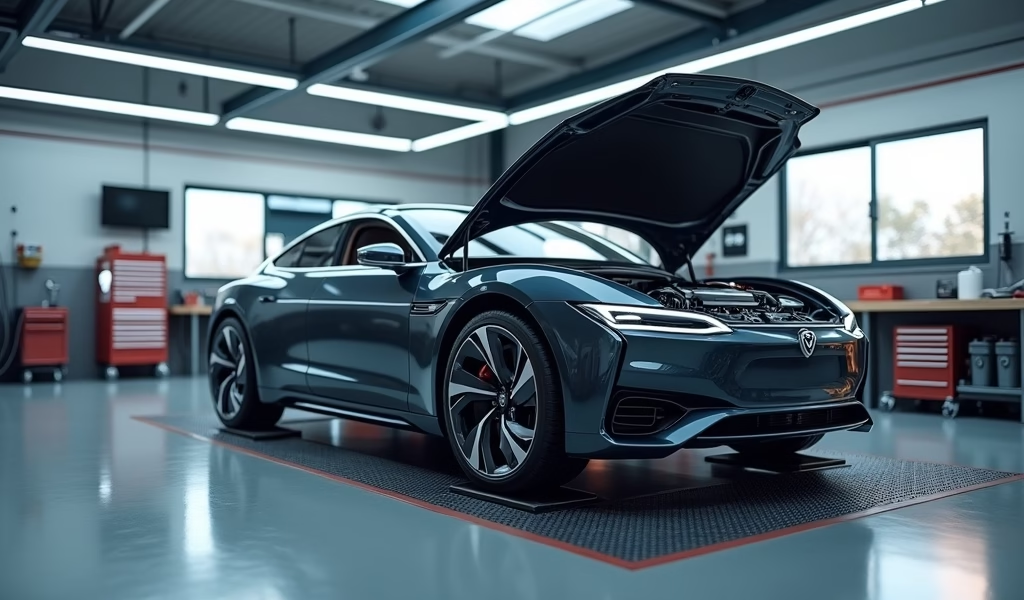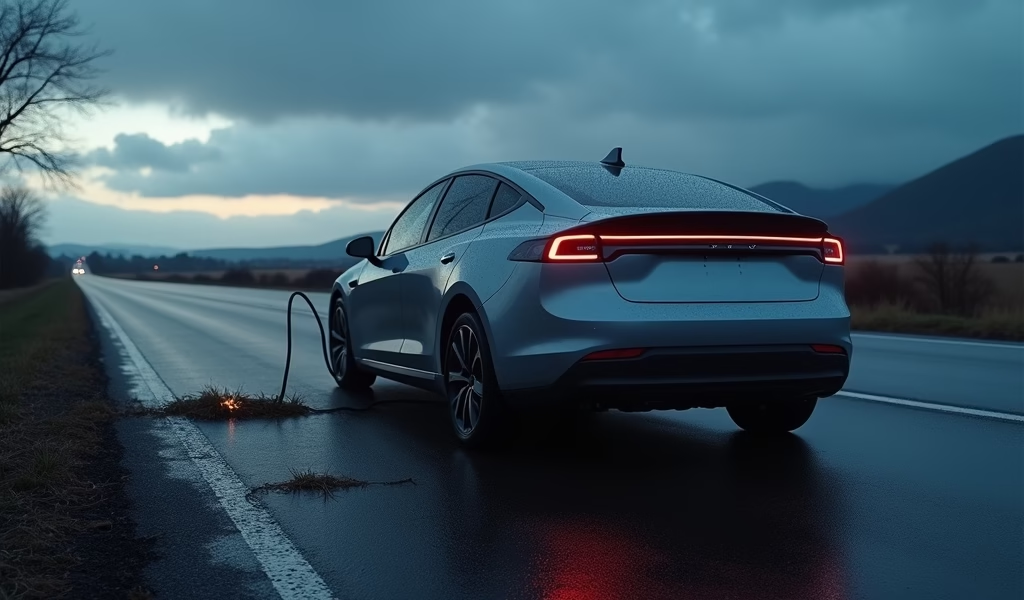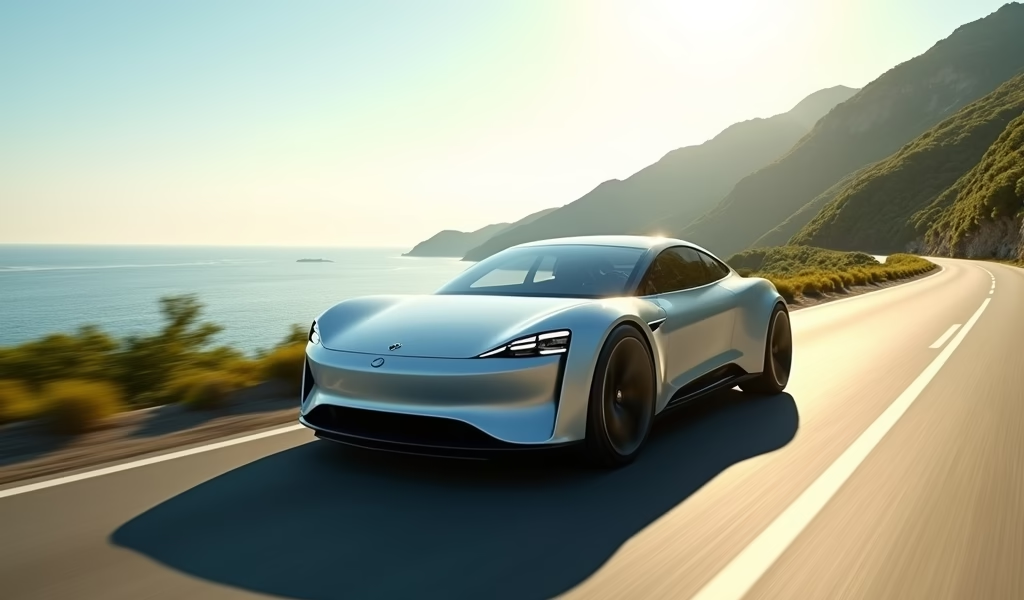Overview
This article provides six essential maintenance tips for electric vehicle owners, focusing on battery care, regenerative braking, climate control, tire maintenance, software updates, and seasonal considerations. Unlike conventional vehicles, EVs require less traditional maintenance but need specific attention to battery health, driving techniques, and software updates to maximize range, performance, and longevity.
Table of Contents
- Electric Car Basics: A New Kind of Maintenance
- Battery Care: The Heart of Your EV
- Mastering Regenerative Braking for Better Range
- Smart Climate Control Strategies
- Tire Maintenance for Maximum Efficiency
- Staying Current: Software Updates Matter
- Seasonal Care for Your Electric Vehicle
- Conclusion: Embracing the Electric Future
Electric Car Basics: A New Kind of Maintenance
The world of driving an electric car brings with it a refreshing change to the maintenance routine. Gone are the days of oil changes, timing belt replacements, and exhaust system repairs. As a mechanic who’s worked on both conventional and electric vehicles, I can tell you firsthand that EV maintenance isn’t harder—it’s just different.
Electric vehicles have fewer moving parts than their gas-guzzling cousins. No spark plugs to replace, no transmission fluid to change, and no exhaust system to worry about. This simplicity translates to fewer shop visits and potentially thousands saved over the vehicle’s lifetime. That said, EVs still need love and attention—just in different ways.
Understanding these differences is crucial for any new electric vehicle owner. When you step into the world of electric driving, you’re not just changing how you fuel your car; you’re adopting a whole new relationship with your vehicle. The good news? Many fascinating facts about electric cars point to their improved reliability and longevity when properly maintained.
Let’s dive into the six essential care tips that will keep your electric vehicle running smoothly for years to come. These insights come from both my personal experience working with hundreds of EVs and the collective wisdom of the industry’s top technicians.
Battery Care: The Heart of Your EV
If there’s one component that defines your electric vehicle, it’s the battery pack. Think of it as both the engine and fuel tank combined—it’s that important. Proper battery care can be the difference between a vehicle that holds its range for a decade and one that starts significantly degrading after just a few years.
First and foremost, avoid regularly charging to 100% unless you need the full range for a trip. Most manufacturers recommend keeping your battery between 20% and 80% charged for daily use. This “Goldilocks zone” reduces stress on the battery cells and extends their useful life. Many EVs allow you to set charging limits through their controls or smartphone apps—I strongly recommend using this feature.
Temperature management is another critical factor in battery health. Extreme heat and cold are both enemies of lithium-ion batteries. Whenever possible, park in garages or shaded areas during hot weather. If you live in a region with harsh winters, try to keep your vehicle plugged in during extremely cold nights, even if it’s already charged—this allows the battery management system to keep the cells at optimal temperature.
Surprisingly, how often you charge matters less than how deeply you discharge. Occasional deep discharges (running down to near empty) won’t harm modern EV batteries, but making it a regular habit can accelerate degradation. According to research from the U.S. Department of Energy, battery life can be significantly extended by avoiding regular deep discharges and extreme temperatures.
When it comes to charging speed, slower is generally kinder to your battery. DC fast charging is convenient for road trips, but for regular daily charging, Level 2 (240V) home charging is the sweet spot between speed and battery preservation.

Mastering Regenerative Braking for Better Range
One of the most fascinating features of driving an electric car is regenerative braking—a system that converts kinetic energy back into electricity when you slow down. Unlike conventional vehicles that waste energy as heat through friction braking, EVs can recapture some of this energy and return it to the battery.
Learning to maximize regenerative braking can significantly extend your vehicle’s range. The technique is simple but requires adjusting your driving style: anticipate stops earlier and gradually ease off the accelerator rather than maintaining speed and then braking hard. This gentle deceleration maximizes energy recapture.
Most electric vehicles offer adjustable regenerative braking settings. Some drivers prefer the stronger settings that enable “one-pedal driving”—where simply lifting off the accelerator provides enough braking force for most situations. Others find a lighter setting more comfortable, especially when transitioning from a conventional vehicle. Experiment with different levels to find your sweet spot.
Here’s a pro tip from the shop: regenerative braking reduces wear on your friction brake components dramatically. I’ve seen EVs with 60,000+ miles that still have most of their original brake pad material. However, this reduced use can lead to corrosion or sticking in certain climates. Make it a habit to use your conventional brakes occasionally with moderate force to keep them clean and functioning properly.
Remember that regenerative braking is less effective when your battery is fully charged (there’s nowhere to store the recaptured energy) and in extremely cold weather. Plan accordingly during winter driving or when starting with a full battery.
Smart Climate Control Strategies
Heating and cooling can dramatically impact your electric vehicle’s range—much more so than in conventional cars. In a gas-powered vehicle, cabin heat is essentially free, coming from the engine’s waste heat. In an EV, every bit of climate control energy comes directly from your battery.
The smartest strategy is to precondition your vehicle while it’s still plugged in. This means warming or cooling the cabin before you unplug and drive away. Most EVs allow scheduling this via their app, so your car is comfortable when you’re ready to leave, without sacrificing range. I tell all my customers this is the single most effective habit to develop for winter EV driving.
When you must use climate control on the road, consider these battery-saving techniques:
- Use seat heaters instead of cabin heat when possible (they use far less energy)
- In summer, use the recirculation mode once the cabin is cool
- For short trips in moderate weather, consider skipping climate control entirely
- Park in the shade in summer and in sunny spots during winter when possible
Modern electric vehicles are increasingly equipped with heat pump systems rather than resistive heaters. If you’re shopping for a new EV and live in a cold climate, prioritize models with heat pumps—they can use up to 70% less energy for heating, which means significantly better winter range.
As someone who’s personally experienced the disadvantages of electric cars in extreme weather, I can assure you that smart climate control usage makes a huge difference. During Wisconsin winters, I’ve seen identical EV models with as much as 30% range difference based solely on how the drivers managed their climate settings.
Tire Maintenance for Maximum Efficiency
Tires play an outsized role in electric vehicle efficiency. Because EVs are generally heavier than their gas-powered counterparts and deliver instant torque, tire care requires special attention.
First and foremost, maintain proper inflation pressures—check them at least monthly and before any long trips. Many EV manufacturers recommend higher pressures than you might be used to from conventional vehicles. This isn’t just about range; it’s about accommodating the vehicle’s weight and performance characteristics. A study by the National Highway Traffic Safety Administration found that properly inflated tires can improve efficiency by up to 3%.
When it’s time for replacement, consider investing in tires specifically designed for electric vehicles. These specialized tires offer lower rolling resistance, better load capacity for handling EV weight, and are engineered to cope with instant torque delivery. They also tend to produce less road noise, which is more noticeable in the quieter EV cabin environment.
Rotation remains important, though the pattern may differ from what you’re used to. Many EVs wear tires more evenly than conventional front-wheel or rear-wheel drive vehicles, but regular rotation still extends overall tire life. Follow your manufacturer’s recommended rotation schedule and pattern—typically every 6,000-8,000 miles.
One EV-specific concern is tire wear indicators. Because electric vehicles can deliver full torque instantly, aggressive acceleration can wear tires faster than expected. Develop smooth acceleration habits to maximize both tire life and range. Your tires (and wallet) will thank you.

Staying Current: Software Updates Matter
If conventional vehicles are mechanical beasts, electric cars are rolling computers. Software governs nearly every aspect of your EV’s operation, from power delivery to charging behavior to cabin comfort. Keeping this software updated is as important as any physical maintenance.
Many electric vehicles can receive over-the-air updates, similar to your smartphone. These updates often do more than add features or fix bugs—they can improve efficiency, extend range, and even enhance battery longevity. Tesla, for instance, has delivered updates that increased range and charging speeds for existing vehicles without any hardware changes.
When your vehicle notifies you of available updates, try to schedule them during times when your car is parked at home and connected to both power and WiFi. Some updates can temporarily drain the battery during installation, and having a stable connection ensures the process completes properly.
Beyond the vehicle itself, keep your manufacturer’s smartphone app updated as well. These companion apps often receive new features that make EV ownership more convenient, such as improved charging station finders or better energy usage analytics.
If you’re experiencing any unusual behavior with your EV, check whether software updates are available before visiting a service center. Many issues that would require physical repair in conventional vehicles can be resolved with software patches in modern electric cars. This is one of the key electric cars pros and cons worth considering—fewer mechanical issues but more dependence on software functioning correctly.
Seasonal Care for Your Electric Vehicle
Electric vehicles, like all cars, face different challenges as the seasons change. Adapting your care routine accordingly can make a significant difference in performance, comfort, and range.
Winter presents unique challenges for EV owners. Cold temperatures can temporarily reduce battery capacity by 10-40%, depending on how extreme the cold is and your vehicle model. Preconditioning becomes especially important—warming your battery while still connected to power can significantly improve range. If you regularly drive in sub-freezing temperatures, consider these additional winter tips:
- Keep your vehicle plugged in overnight when possible, even when fully charged
- Use scheduled departure features to ensure the battery is warm when you leave
- Drive more conservatively in extremely cold weather
- Allow extra time and range for winter journeys
Summer brings its own considerations. Extreme heat can accelerate battery degradation over time, though modern thermal management systems mitigate this considerably. When possible, park in shaded areas or garages during heat waves. Using scheduled pre-cooling while still plugged in not only improves comfort but also reduces battery drain once you’re on the road.
Spring and fall are generally the friendliest seasons for EVs, often delivering range that exceeds manufacturer estimates. These moderate seasons are ideal times for longer road trips and exploring the limits of your vehicle’s capabilities.
Regardless of season, washing your EV regularly helps maintain efficiency by removing dirt that can increase drag. Pay particular attention to keeping charge ports clean and dry—this prevents connection issues that can interrupt charging.
If you’re planning to store your EV for an extended period (more than a few weeks), consult your owner’s manual for specific guidance. Generally, leaving the battery at a moderate charge level (around 50%) in a temperature-controlled environment is ideal for long-term storage.
Conclusion: Embracing the Electric Future
Driving an electric car represents more than just a different way to power your vehicle—it’s embracing a new relationship with transportation. The maintenance needs might be different, but they’re typically less demanding in both time and cost than conventional vehicles require.
By focusing on these six key areas—battery care, regenerative braking, climate control, tire maintenance, software updates, and seasonal considerations—you’ll maximize your EV’s performance, range, and longevity. These habits will quickly become second nature, just as checking oil levels once was for gas-powered car owners.
The electric revolution is well underway, and understanding how to properly care for these vehicles is becoming essential knowledge for modern drivers. Whether you’re a seasoned EV owner or considering making the switch, these practices will help ensure your electric driving experience remains positive for years to come.
At Knows Your Car, we’re committed to helping you navigate the evolving world of automotive care. If you have specific questions about your electric vehicle or need professional assistance, don’t hesitate to reach out. Our team of EV-certified technicians understands the unique needs of electric vehicles and can help you keep yours performing at its best.
Ready to take your EV knowledge to the next level? Schedule a comprehensive electric vehicle inspection today, and let our experts assess your battery health, charging system, and overall performance. Your electric car deserves specialized care from those who truly understand its technology—contact us now to book your appointment and ensure you’re getting the most from your EV investment.
Frequently Asked Questions
How often should I fully charge my electric car to 100%?
For daily use, charging to 80% is better for battery longevity. Reserve 100% charges only for long trips when you need maximum range.
Can I use regular car washes for my electric vehicle?
Yes, electric vehicles can go through standard car washes safely. Just ensure the charge port door is securely closed before entering.
Do electric cars need oil changes?
No, electric vehicles don’t require oil changes because they don’t have internal combustion engines. This is one of the major maintenance savings with EVs.
How long do electric car batteries typically last?
Most modern EV batteries are designed to last 10-20 years before significant degradation occurs. Many manufacturers warranty their batteries for 8-10 years or 100,000+ miles.
Should I charge my EV every night?
Daily charging is fine as long as you’re not regularly charging to 100%. Setting your charge limit to 80% for daily use is ideal for battery health.


Pingback: Electric Vehicles Explained: 5 Pro Tips - knowsyourcar.com